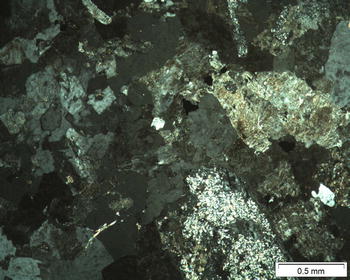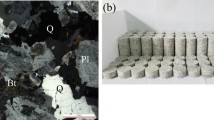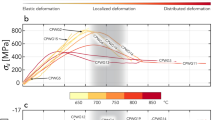Abstract
Permeability is an important factor for seepage analysis of rock material, and a key factor in ensuring the safety of underground works. In this study, the permeability evolution of granite gneiss during triaxial creep tests was investigated. In the context of an underground oil storage cavern in China, a series of hydro-mechanical coupling creep tests were conducted on rock cores of granite gneiss at three different pore pressures to reveal the effect of pore pressure on the permeability evolution and to investigate the correlation between the permeability and volumetric strain during the creep process. During the creep tests, the permeability decreases in the initial loading phase. At all deviatoric stress levels, the permeability remains stable in the steady creep stage and increases rapidly in the accelerated creep stage. Based on the test data, the initial permeability, steady permeability and peak permeability at various stress levels are defined. The effect of pore pressure on the permeability is captured by a linear model. In addition, the relationship between permeability and volumetric strain can be described as a process divided into three phases, with different functions in each phase.







Similar content being viewed by others
References
Bolton A, Maltman A (1998) Fluid-flow pathways in actively deforming sediments: the role of pore fluid pressures and volume change. Mar Petrol Geol 15:281–297
Brace WF, Walsh JB, Frangos WT (1968) Permeability of granite under high pressure. J Geophys Res 73:2225–2236
Dong JJ, Hsu JY, Wu WJ, Shimamoto T, Hung JH, Yeh EC, Wu YH, Sone H (2010) Stress-dependence of the permeability and porosity of sandstone and shale from TCDP Hole-A. Int J Rock Mech Min 47:1141–1157
Heidari M, Khanlari GR, Torabi-Kaveh M, Kargarian S, Saneie S (2014) Effect of porosity on rock brittleness. Rock Mech Rock Eng 47:785–790
Heiland J (2013) Laboratory testing of coupled hydro-mechanical processes during rock deformation. Hydrogeol J 11:122–141
Heiland J, Raab S (2001) Experimental investigation of the influence of differential stress on permeability of a Lower Permian (Rotliegend) sandstone deformed in the brittle deformation field. Phys Chem Earth A 26:33–38
Jiang T, Shao JF, Xu WY, Zhou CB (2010) Experimental investigation and micromechanical analysis of damage and permeability variation in brittle rocks. Int J Rock Mech Min 47:703–713
Kranz RL, Frankel AD, Engelder T, Scholz CH (1979) The permeability of whole and jointed barre granite. Int J Rock Mech Min 16:225–234
Lee JH, Rhee KY, Park SJ (2010) The tensile and thermal properties of modified CNT-reinforced basalt/epoxy composites. Mater Sci Eng A 527:6838–6843
Liu L, Xu WY (2015) Experimental researches on long-term strength of granite gneiss. Adv Mater Sci Eng 2015:1–9
Liu L, Xu WY, Wang HL, Wang RB, Wang W (2016) Experimental studies on hydro-mechanical properties of metamorphic rock under hydraulic pressures. Eur J Environ Civ Eng 20:45–59
Maranini E, Brignoli M (1999) Creep behaviour of a weak rock: experimental characterization. Int J Rock Mech Min 36:127–138
Megawati M, Hiorth A, Madland MV (2013) The impact of surface charge on the mechanical behavior of high-porosity chalk. Rock Mech Rock Eng 46:1073–1090
Shimazu T, Miura M, Isu N, Ogawa T, Ota K, Maeda H, Ishida EH (2008) Plastic deformation of ductile ceramics in the Al2TiO5–MgTi2O5 system. Mater Sci Eng A 487:340–346
Tsai LS, Hsieh YM, Weng MC, Huang TH, Jeng FS (2008) Time-dependent deformation behaviors of weak sandstones. Int J Rock Mech Min 45:144–154
Tsang C, Bernier F, Davies C (2005) Geohydromechanical processes in the Excavation Damaged Zone in crystalline rock, rock salt, and indurated and plastic clays—in the context of radioactive waste disposal. Int J Rock Mech Min 42:109–125
Ulusay R, Hudson JA (2007) The complete ISRM suggested methods for rock characterization, testing and monitoring. Iskitler, Ankara
Walton G, Arzua J, Alejano LR, Diederichs MS (2014) A laboratory-testing-based study on the strength, deformability, and dilatancy of carbonate rocks at low confinement. Rock Mech Rock Eng 48:941–958
Wang JA, Park HD (2002) Fluid permeability of sedimentary rocks in a complete stress–strain process. Eng Geol 63:291–300
Wang HL, Xu WY, Shao JF, Skoczylas F (2014) The gas permeability properties of low-permeability rock in the process of triaxial compression test. Mater Lett 116:386–388
Wang HL, Xu WY, Jia CJ, Cai M, Meng QX (2016) Experimental research on permeability evolution with microcrack development in sandstone under different fluid pressures. J Geotech Geoenviron Eng. doi:10.1061/(ASCE)GT.1943-5606.0001462
Yang SQ, Jing HW, Cheng L (2014) Influences of pore pressure on short-term and creep mechanical behavior of red sandstone. Eng Geol 179:10–23
Zhang Y, Liu ZB, Xu WY, Shao JF (2015a) Change in the permeability of clastic rock during multi-loading triaxial compressive creep tests. Geo Lett 5:167–172
Zhang Y, Shao JF, Xu WY, Jia Y, Zhao HB (2015b) Creep behaviour and permeability evolution of cataclastic sandstone in triaxial rheological tests. Eur J Environ Civ Eng 19:496–519
Zoback MD, Byerlee JD (1975) The effect of micro crack dilatancy on the permeability westerly granite. J Geophys Res 80:752–755
Acknowledgments
This work was supported by the National Natural Science Foundation of China (Nos. 11172090, 51479049 and 51209075).
Author information
Authors and Affiliations
Corresponding author
Rights and permissions
About this article
Cite this article
Liu, L., Xu, W.Y., Wang, H.L. et al. Permeability Evolution of Granite Gneiss During Triaxial Creep Tests. Rock Mech Rock Eng 49, 3455–3462 (2016). https://doi.org/10.1007/s00603-016-0999-8
Received:
Accepted:
Published:
Issue Date:
DOI: https://doi.org/10.1007/s00603-016-0999-8




